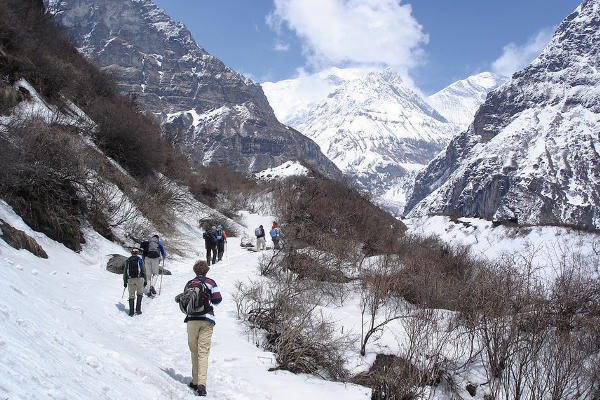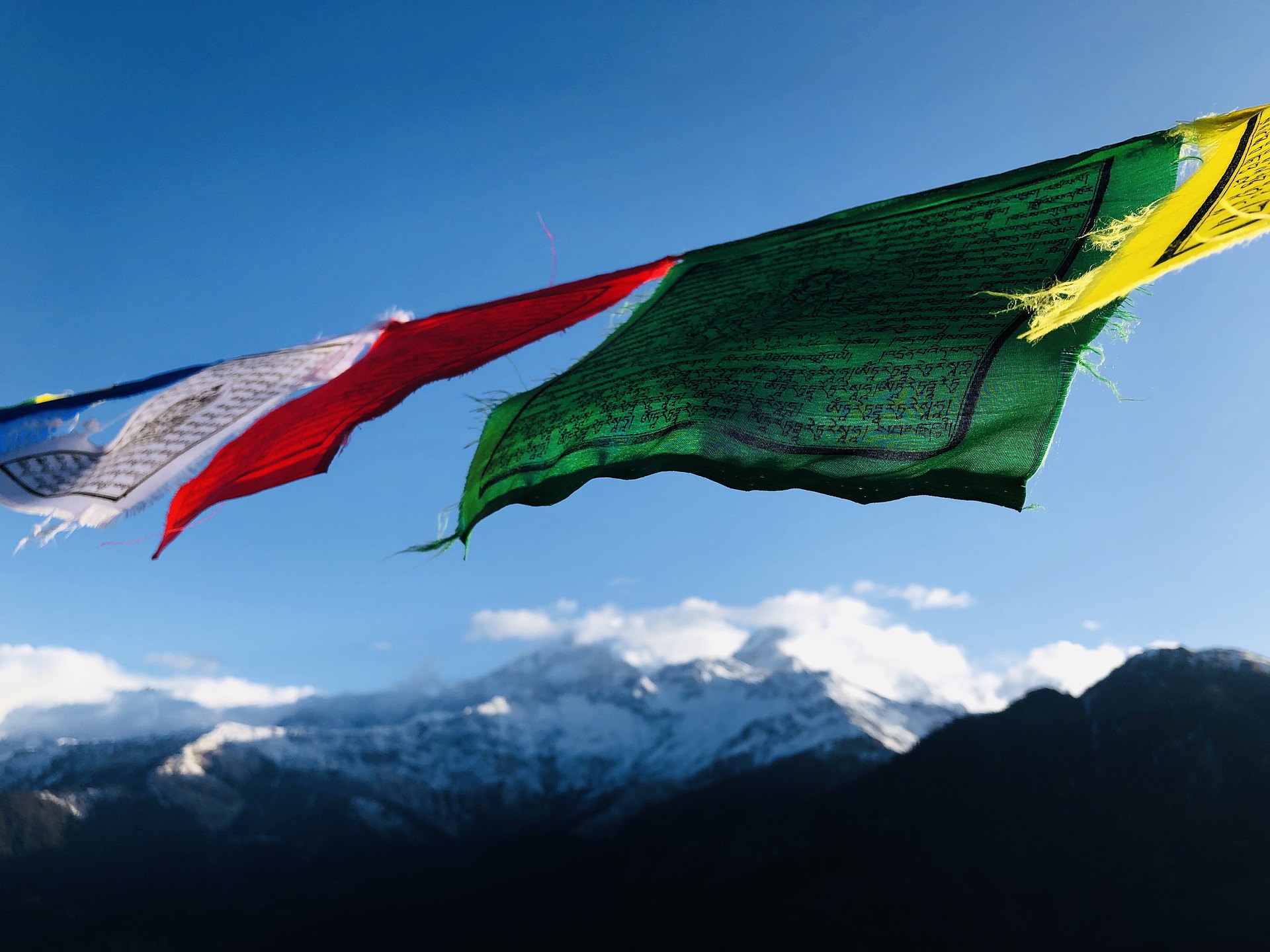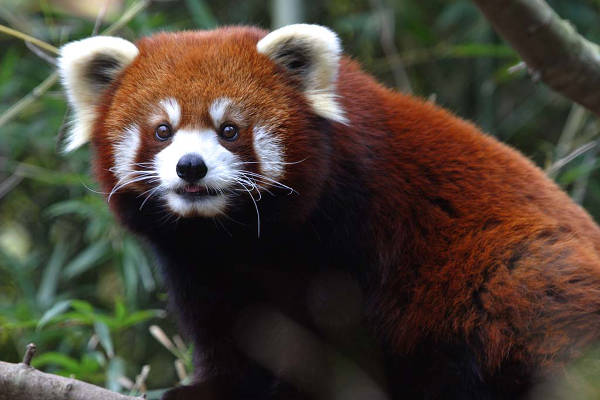Apart from being the home to some of the highest mountain peaks and breath-taking views in the world, Nepal is particularly popular as it offers a vast variety of trekking routes.
There are short routes and long routes, easy routes and challenging routes, busy routes and remote routes. There are routes for young trekkers and families, as well as routes for veteran trekkers and adventure-seekers.
Nowadays, there are even routes that offer healthy living experiences that encompass meditation, yoga and cultural tours to traditional Nepalese villages.
In this article, we'll explore the best Nepal treks by region.
Nepal Trekking Routes by Region
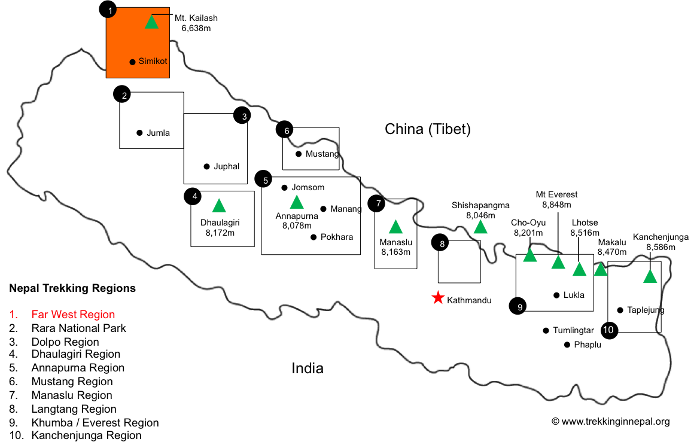
Far West Region
The Far West Region of Nepal is often overlooked due to it’s rather remote geographic location and poor infrastructure. However, this is fast changing due to a large investment and promotion effort that begun in 2008.
The region offers an authentic trekking experience that is hard to match in any of the other regions. Covering just over 25% of the Great Himalayan Range (if you include Rara National Park), the region is the largest in Nepal.
The region is home to the second largest district in Nepal, Humla, in the North and Darchula, Bajura and Bajhang in the South.
Trekking routes are still undeveloped and rustic in the region, with little in the way of established accommodation and availability of foodstuffs. However, these characteristics give the region a charm and wonder reminiscent of what early 1950s explorers must have experienced when Nepal first opened up to foreigners.
If you are looking to escape the crowds and experience an untouched environment, then the Far West region is for you. The Limi Valley Trek is the most popular in the region. Also see the great Himalayan trail.
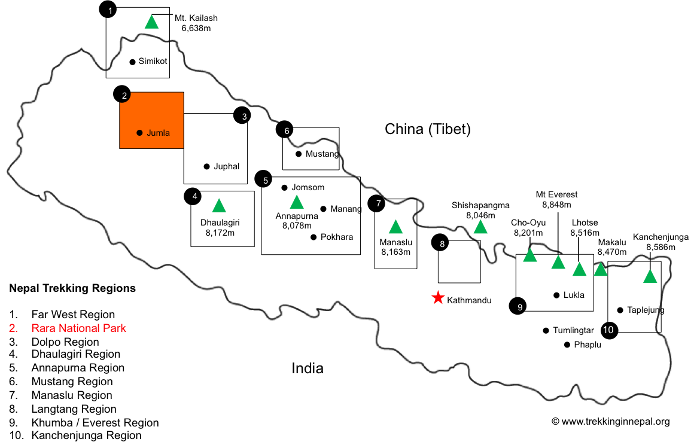
Rara National Park
Established in 1976, Rara National Park is an area of incredible natural beauty. It lies in the North-west of the country in a remote area called Karnali and houses Rara Lake – Nepal’s largest lake.
Like treks in the Far Western Region, there are a number of trek variations, but the most popular is the Rara Lake Trek; a 10-14 day hike that provides an ‘off-the-beaten’ track experience characterised by pristine natural beauty, snow-capped Himalaya peaks that reflect off the glassy Rara Lake and the best opportunity to view wildlife like musk deer, tahr, Himalayan black bear, leopards, ghoral and, if you are lucky, the red panda.
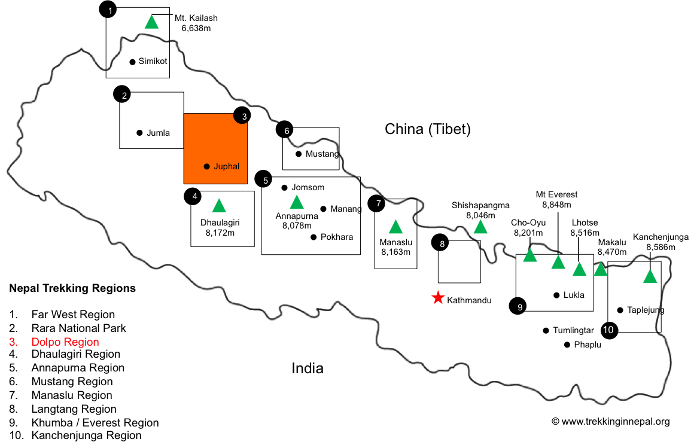
Dolpo Region
The Dolpo Region is another remote and incredibly beautiful part of Nepal. It runs from the border of Tibetan Plateau in the North, often referred to as the Upper Dolpo, to the large east-west valley system that sits in the South, or Lower Dolpo.
To the east are the Khyaklum and Dhaulagiri Himals which create a border with the Mustang and Annapurna region respectively, and give Dolpo a sense of isolation from the rest of Nepal.
Most trekkers enter the Dolpo via Juphal and then follow various routes either in the Lower Dolpo region or further North and West in the Upper Dolpo or Mustang.

Dhaulagiri Region
The Dhaulagiri Region houses the seventh highest mountain in the world, Mt. Dhaulagiri (8,137 meters), and is one of the more remote areas of Nepal.
The region is ideal for experienced high-altitude trekkers who are looking to avoid the crowds that are common in the Annapurna, Langtang and Khumba regions. Treks in the region are only available in the Autumn months (October through December) as heavy snow and ice conditions in the winter and spring make the region inhospitable.
The most popular hike in the region is the Dhaulagiri Circuit Trek (15-18 days). The trek is not for the faint-hearted. It includes strenuous hiking at high altitude and potential use of ropes on the moraines near Dhaulagiri Base Camp. Traversing the awe-inspiring French and Dhampus passes, the Dhaulagiri Circuit Trek is, in our opinion, one of the finest in Nepal!
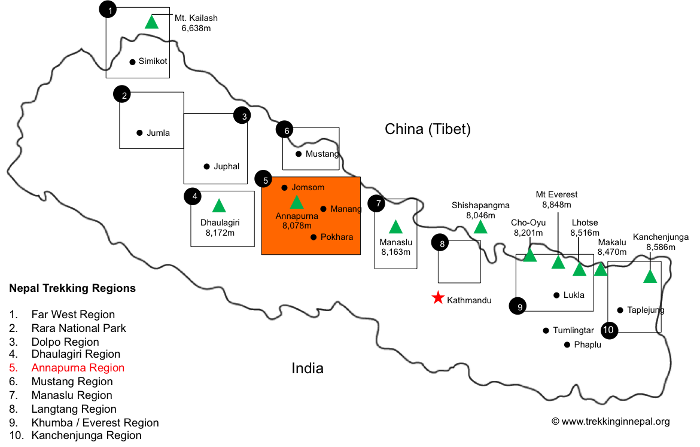
Annapurna Region
The Annapurna region is one of the most popular trekking area in Nepal. It is situated just north of the trekking city of Pokhara and encompasses Annapurna I, the 10th highest mountain in the world at 8,091 meters, as well as 13 mountain peaks over 7,000 meters and 16 more peaks over 6,000 meters.
The area is characterised by alpine meadows, glaciers and moraines.
The main trekking routes in the Annapurna region can be seen below.
Annapurna Circuit (up to 3 weeks)
The Annapurna circuit is one of the most iconic treks in the world, although road development in recent years has led to lots of negative publicity. The trek follows a counter-clockwise route, passing through the Lamjung, Manang, Mustang and Myagdi regions. Perfect for trekkers with lots of spare time on their hands.
Annapurna Base Camp Trek (7-14 days)
The Annapurna BC hike is a popular trek as it can be reached via various routes including the sanctuary trek above.
Annapurna Sanctuary Trek (~14 days)
A classic trek that starts either at Phedi or Nayapul, north of Pokhara and traverses the Annapurna Sanctuary via Chomrong to Annapurna Base Camp.
Jomsom Muktinath Trek (5-13 days)
The Jomsom Muktinath hike is a moderate to easy trek in the Mustang region, north of the Annapurna Range. The trek includes awe-inspiring views of Annapurna, traversing the Kali Gandaki River – the world’s deepest gorge.
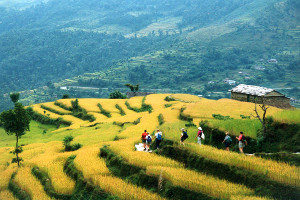
The Royal Trek (3-4 days)
The Royal hike is one of the shortest and easiest treks in Nepal, the Royal trek follows the same path taken by Prince Charles in the 1980s and takes its name from this excursion. Great for trekkers who have limited time and are looking for a light and easy trekking experience.
Ghorepani Poon Hill Trek (3-5 days)
The Poon Hill hike is a short, but beautiful trek that typically starts at Nayapul which is one-hour drive from Pokhara. A relatively easy trek, with a maximum elevation of 3,200 meters.
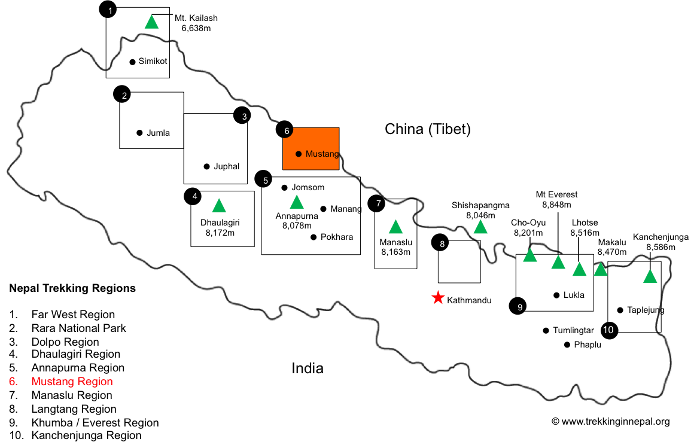
Mustang Region
Mustang lies North-west of Annapurna and extends north onto the Tibetan Plateau. The Upper Mustang region is still home to ancient Mustang-Tibetan communities that sit in stark contrast to the advancing modernisation of Nepal.
The main trail in Mustang runs North-South from Lo Monthang to Jomsom, and all treks require restricted access permits.
Below are the two most popular trekking routes.
Mustang Circuit (12-14 days)
The Mustang circuit begins in Jomsom and can be combined with various trails to Naar, Damadhar Kund, Saribung and Muktinath. The highest point is Mui La at 4,170 meters and difficulty is easy to moderate.
Upper Mustang Trek (18-20 days)
Typically, the Upper Mustang Trek is a continuation of the Mustang Circuit to the Northern communities of the Upper Mustang region. Ideal for those looking to experience the fascinating lives of ancient Mustang communities.
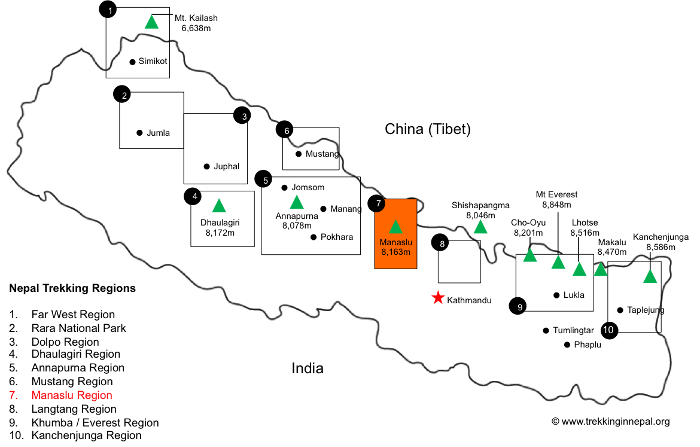
Manaslu Region
Situated in the centre of Nepal, the Manaslu Region encompasses both the Manaslu and Ganesh Himals. The latter consists of seven major peaks which form a natural border with Tibet in the North. Further south-west is the massive summit of Manaslu (8,163 meters), the eighth highest mountain in the world.
Apart from the striking natural beauty of the region, the area is also culturally diverse offering trekkers rich insight into the various groups of Nepalese people that inhabit the regions hills and valleys.
A number of trek variations and trails are available, but the most popular is the Manaslu Circuit Trek, a 12-14 day hike that provides an unbeatable mix of incredible scenery and cultural diversity. Some consider the Manaslu Circuit the finest trek in Nepal. Ideal for the intermediate trekker or anyone with a good degree of fitness.
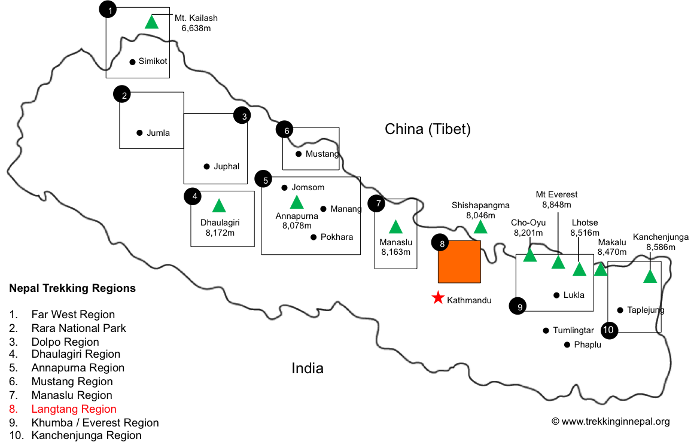
Langtang Region
Mustang lies North-west of Annapurna and extends north onto the Tibetan Plateau. The Upper Mustang region is still home to ancient Mustang-Tibetan communities that sit in stark contrast to the advancing modernisation of Nepal.
The main trail in Mustang runs North-South from Lo Monthang to Jomsom, and all treks require restricted access permits.
Below are the two most popular trekking routes.
Langtang Valley Trek (7-12 days)
The Langtang hike is a popular trek through the Langtang National Park (second largest national park in Nepal). Treks typically begin in Dunche, the main trading post in the area, and follow the beautiful alpine valley to Kyangjin before circling back. Ideal for novice or intermediate trekkers.
Gosainkunda Trek (10-14 days)
Typically encompasses the Langtang Valley Trek and includes a visit to Gosainkunda Lake, a sacred Hindu lake where pilgrims congregate to wash off their sins. The Gosainkunda hike is a popular trek that is usually approached via Trishuli valley, North-west of Kathmandu.
Rolwaling Trek (up to 3 weeks)
Technically situated between the Langtang and Khumba region is the Rolwaling Valley – known as one of the seven hidden valleys in the Himalayas. The area provides a unique quiet spot in a busy region and offers adventurous trekkers and climbers the opportunity to utilise their mountaineering skills as ropes are required!
Helambu Trek (7-10 days)
Helambu hike sits just North of Kathmandu and the area is inhabited by Sherpas and Tamang people. Ideal for trekkers who do not want to venture too far from Kathmandu.
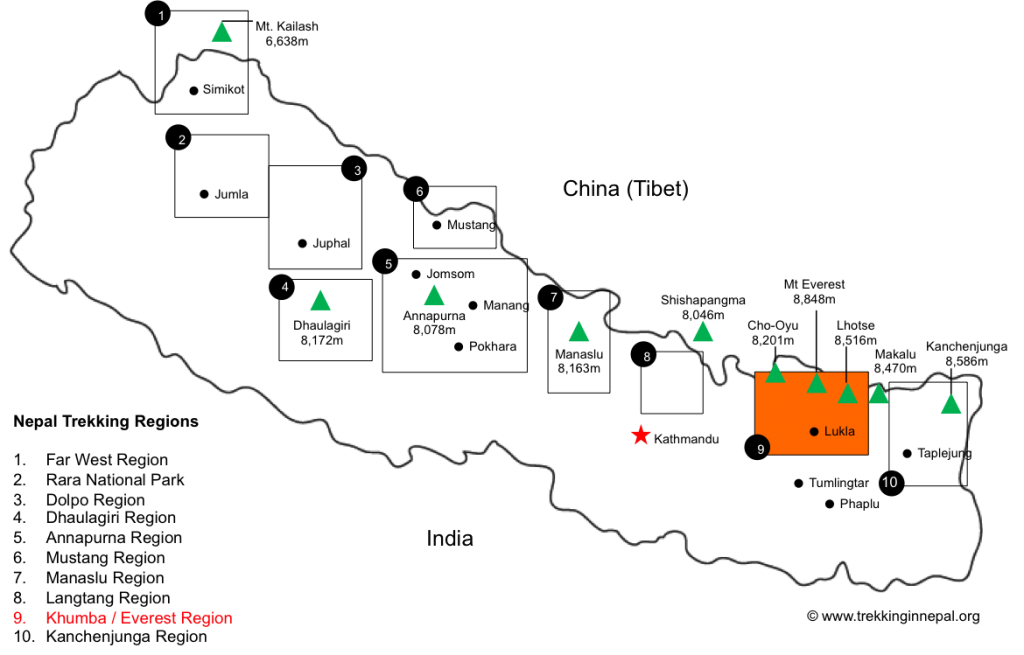
Khumbu / Everest Region
The Everest region, or Khumbu, is based in the Northeast of Nepal and is designated a World Heritage Site. Most of the region is based above 3,000 meters.
The region is grand on all scales. Home to four of the six highest mountains in the world – Mount Everest, Mount Lhotse, Mount Makalu, and Cho Oyu – the region is quite simply one of hyperbole.
See below for Everest Region trekking options.
Everest Base Camp Trek (12-14 days)
An extremely popular trek for obvious reasons, the Everest Base Camp hike provide a moderate to easy trek via the legendary Sherpa village of Namche Bazaar and Tengboche Monastery, the highest Buddhist center in Khumbu. Variations on the EBC Trek include the Gokyo Lakes hike or further ‘climbing’ expedition up Island Peak, are also popular.
Khumbu Valley Trek (12-16 days)
A classic trek due to its location in the shadow of Sagarmatha (Mt. Everest) in the Sagarmatha National Park. A moderate-to-strenuous trek due to its isolated location, the Khumbu valley hike gives a full trekking in Nepal experience.
Makalu Base Camp Trek (18-22 days)
A long and strenuous hike (especially the second half) takes trekkers through the Makalu-Barun National Park in the North-east of the Khumbu region, which houses the fifth highest mountain in the world – Makalu (8,470 meters). Not for the faint-hearted, but a great trek that is surprisingly quiet due to its remote location in the region and lack of tea houses. See the Makalu BC hike.
Mera Peak (Nepal trekking peak)
At 6,746 meters, Mera Peak is classified as a Nepal trekking peak. This is to say that it requires some mountaineering experience with ropes used on the final section to the summit. Only recommended for the adventurous soul who has some previous high-altitude trekking and basic mountaineering skills.
Island Peak (Nepal trekking peak)
A challenging trekking peak in Nepal, Island Peak is usually combined with an Everest Base Camp trek to give one time to acclimatise and prepare for the strenuous ascent of the 6,176-meter summit. Again, this ‘trek’ is only recommended for those with high altitude trekking experience and basic mountaineering skills.
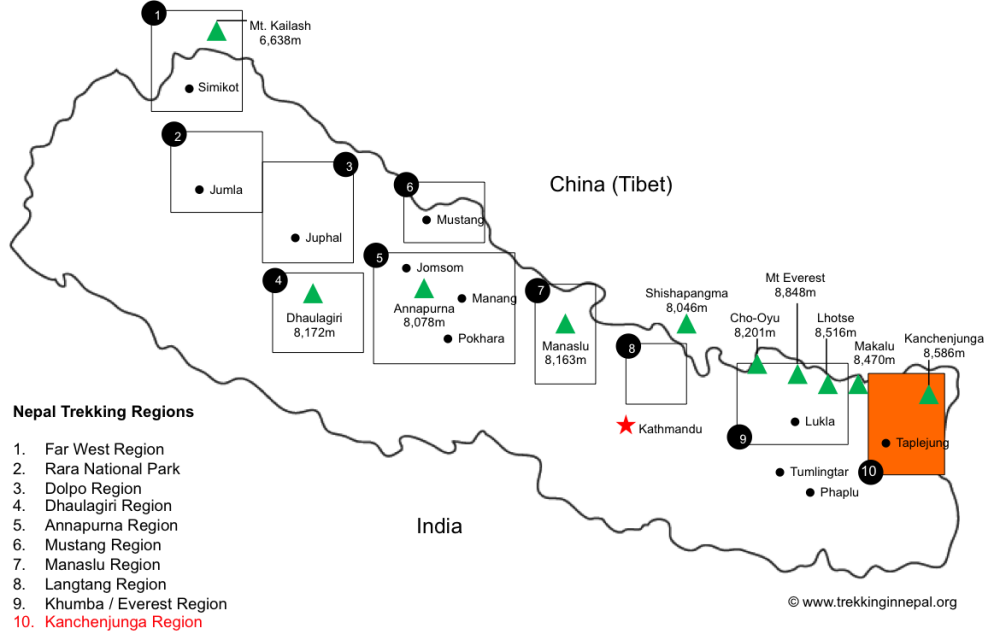
Kachenjunga Region
Home to vast rhododendron forests and the third highest mountain in the world, Mt. Kachenjunga (8,586 meters), this far eastern region of Nepal is remote, rugged and beautiful.
Kanchenjunga massif is characterized by loads of peaks and valleys but can be seen to split into two sections. The southwest face and ridges, around Yalung, and the north face where the Kachenjunga Base Camp is situated.
Treks vary in the region, but most trekkers enter via Taplejung. The most popular trek in the region is the Kachenjunga Base Camp Trek.
Continue browsing...
See more information on Nepal. Or check out these other Nepal hiking articles:

